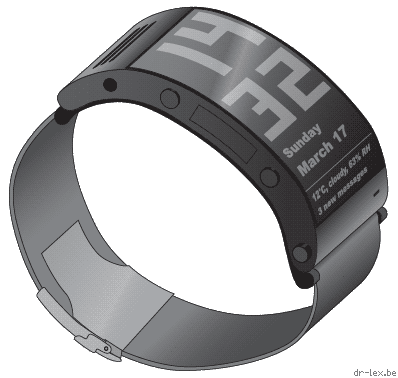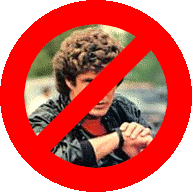Why Current Smartwatches Suck
With the recent release of the Apple Watch, or ‘iWatch’ as it is dubbed, it has become obvious once more that the average company still has no clue how to make a useful wearable device that will not flop badly. Even Apple will need a miracle, even though they previously managed to reinvent the MP3 player as the hugely successful iPod, and later on the cell phone as the equally successful iPhone. Maybe they hope to surf on the expectations created by their previous products when it comes to the Apple Watch. The reviews are scathing: it looks nice but is not useful as a watch, nor as anything else for that matter.
In the hopes of explaining clearly what I believe to be a potentially successful product, here is a very short summary of my much lengthier article: “Watch Phones and Smartwatches – Will someone please design one that doesn't suck?” I recommend reading it if this topic interests you. However, for those in a hurry, here's the gist of it in a few paragraphs.
In the final paragraph, I demonstrate that smartwatches already exist that, although still far from perfect, are a much better match for this list of requirements than the Apple Watch.
- A good smartwatch must be a good watch
- A good smartwatch lasts at least seven days on a single charge
- A good smartwatch looks good
- A good smartwatch is small but has the largest possible screen
- A good smartwatch is waterproof and shockproof
- A good smartwatch must be able to work stand-alone
- A good smartwatch is a watch phone
- A good smartwatch is detachable from its wrist strap
These requirements are sorted according to what I believe to be most important to gain market share, to least. Personally I consider the looks less important, and good phone functionality and detachability essential, but I know the general public currently doesn't care about that.

A good smartwatch must be a good watch
Really, it is ridiculous to call a device a name containing the word ‘watch’ if it is not a practical wristwatch. A true watch must always show the time when it is not being used for anything else. It must not require pushing a button or making some kind of gesture, time must be visible on the display at all times, period. Otherwise it is only marginally less cumbersome than using a smartphone as a pocket watch. I do not care how it is implemented, just make it work. One of the most sensible solutions is a combination of e-ink and LCD display like on the GEAK II.
A good smartwatch lasts at least seven days on a single charge
This is where e.g. the Apple Watch fails miserably, it is a challenge to get through a single day. Mind that the seven days are with normal usage, not the kind of pathological ‘turn off nearly all functions and do not touch it’ tests that are often used to determine the overly optimistic numbers printed in lists of specifications. I know making this possible is as difficult as the continuous time display (which makes this requirement even more difficult!) Nobody however wants to recharge their wristwatch every day, no matter how convenient the charging mechanism is. Again, the GEAK II shows that it is not impossible.
A good smartwatch looks good
When it comes to checking the time, a large share of twenty-first century people apparently are willing to exchange the practicality of a wristwatch for the cumbersomeness of using a smartphone like an eighteenth-century pocketwatch. Many of those who keep on wearing wristwatches, consider them a bit like fashion accessories that also happen to show the time. Only very few people do not really care about the looks of their wristwatch. It would be quite dumb to limit one's market share to those few people only.
A good smartwatch is small but has the largest possible screen
The smartwatch must not be bigger than an actual watch, and I do not mean the kind of stupid wearable wall clocks that were fashionable around the year 2010. Sorry Neptune Pine, you're way too big. Models like the Omate TrueSmart or Abardeen F80 (48×48×13.4 mm body), are quite OK, although still too thick. However, given this small size, the screen must be as large as possible. Every available square millimeter of the top surface must be pixels. In other words, the F80 should have had a 48×48 mm display instead of its tiny 28×28 mm. Of course the screen must offer impeccable multi-touch across the entire surface.
A good smartwatch is waterproof and shockproof
People will be wearing this while walking or biking in the rain. People will be wearing this while falling into a swimming pool. People will be wearing this while a drunken friend (or their drunken selves) spill beer over their arm. People will accidentally drop it or bump it into a hard object. Nobody will want to have their expensive device destroyed in any of these situations.
A good smartwatch must be able to work stand-alone
I know companies love to make sets of products that can only work together, because those companies are quite often run by short-sighted people who draw straight lines between the two nearest points they can find, and then extrapolate this line into infinity. I also know however that the general public has a deep hatred for tied sales. Most people do not see the point of having a device that is nothing but a rather unpractically small wireless screen for their main phone, and they are totally right. We have cloud services everywhere, so why stick to the bygone concept of companion devices? The watch must have full functionality at all times. This means it must be able to go online on its own. This means indeed it should be possible to install a SIM card. And it is not because it is a tiny device, that it should have a crappy connection. Make it snappy, make it 4G.
A good smartwatch is a watch phone
This will be the point where many people will start to object, but look at it this way. Our good smartwatch has the following components:
- A SIM card slot so it can be used stand-alone.
- A loudspeaker, because it must be able to play alarms and read messages aloud.
- A microphone, so people can use voice commands, record memos, or use an app like Shazam or SoundHound.
In other words, this device will have all the hardware to make it work as a cell phone. I know the general public is not asking for this at this time, but believe me: it would be terribly frustrating if someone would badly need to make a phone call while knowing they are wearing a device that has all the hardware required to make calls, only not in the right configuration. Those who do not care about this functionality, can just ignore it. It is possible to make such a tiny device work well as a phone, because I have tested watch phones with good sound quality, so do not give me that excuse.
A good smartwatch is detachable from its wrist strap
This is a corollary of the previous. If it is a phone or can act like a bluetooth headset for a phone, it must be possible to hold it like a phone. Forget about talking to your wrist like Knight Rider or Dick Tracy: it is stupid, ridiculous, unpractical, and only children want to do it. Moreover, wearing a phone on one's wrist leads to reduced signal strength and worse sound quality. Even for those who will never use it as a phone, a detachable device is damn practical no matter what. Look at the Neptune Pine: it converts from a watch into a camera or a helmet-mounted action cam by just sliding it in and out of its accessories. Look at the Abardeen F80: it becomes a tiny camera, camcorder, or bicycle navigation unit in a split second.

Quite Decent Smartwatches Already Exist
The only redeeming quality of the Apple Watch is that it finally managed to make the general public aware of these kind of devices that have been existing for at least seven years, often in forms more advanced than the Apple Watch itself. Nine months before the Apple watch was released, I bought a smartwatch for about half the price of an Apple Watch. It can:
- make phone calls all on its own, because it has a SIM card. It does not need to be tethered to another phone, it is a telephone.
- connect to Wi-Fi and EDGE cellular data networks.
- take rather good 5 MPixel photos and record 720p videos.
- offer geolocation and orientation with its built-in GPS and compass. It also has an ambient light sensor.
- last 72 hours on a single battery charge, with light but non-pathological usage (i.e. every day, make a short call, browse some webpages, take some photos).
- can run any Android app that is designed properly enough to still work on a tiny screen. I can read and send mails, browse webpages, play videos, recognise songs with Shazam, run a Samba file server, record GPS tracks, get GPS directions, and so on.
- use bluetooth keyboards (and even mice) for input.
- offer quite usable text input without an external keyboard, by means of a half-size keyboard (common letters are tapped, less commonly used letters are accessed by sliding).
- slide out of its wristband such that it can be held like a normal telephone, or be mounted in other receptacles very easily. This also makes it much more useful as a camera.
- accept a standard TRRS headset for playing music or making phone calls.
The only sensor it lacks compared to the Apple Watch, is the infamous heart rate sensor that fails for people with tattooed skin. I quote the current Wikipedia page about smartwatches: overall, users of the Apple Watch have indicated that the wearable is the most advanced in terms of usability on the market today.
I suspect that those users draw that conclusion because they only tested against models even more useless than the Apple Watch. Or maybe they have a different idea about ‘usability’ than me. Or maybe Wikipedia just is not as independent as it claims to be.
This Abardeen F80 smartwatch of mine, or rather watch phone, is still far from perfect, and it is not very fashionable. Yet it proves surprisingly usable, despite having a bog-standard Android operating system with only minor tweaks to adapt it to the tiny screen. It could be much better if someone would take the effort of designing a proper user interface. It is a Chinese product created by people who do not have the kind of R&D of a company like Apple's. But at least they had an idea of making something that fulfils actual consumer needs, because I like this thing more than enough to put up with its limitations.
If one looks around, for every requirement in my list there is already at least one product that fulfils it. I have found no products however that fulfil more than half of the requirements. If only some company would combine all the existing technology, my ultimate vision of a watch phone could become reality.